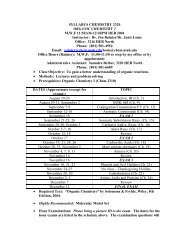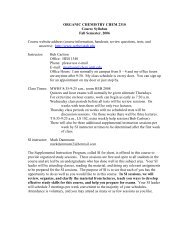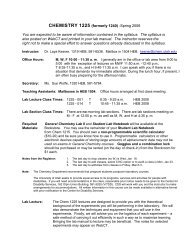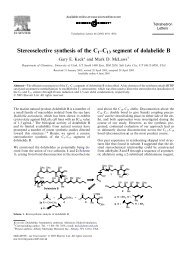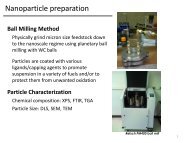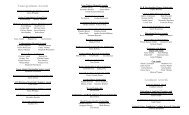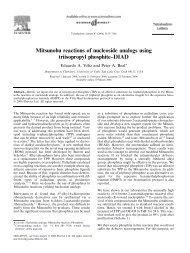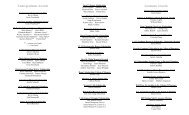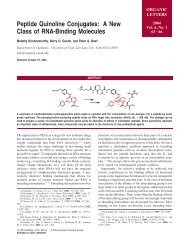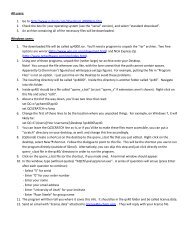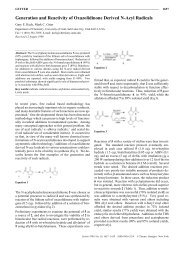E. M. Purcell's “Life at Low Reynolds Number”
E. M. Purcell's “Life at Low Reynolds Number”
E. M. Purcell's “Life at Low Reynolds Number”
- No tags were found...
You also want an ePaper? Increase the reach of your titles
YUMPU automatically turns print PDFs into web optimized ePapers that Google loves.
E. M. Purcell’s <strong>“Life</strong> <strong>at</strong> <strong>Low</strong> <strong>Reynolds</strong><strong>Number”</strong>Random Walks in Biology SeriesEric PetersonMarch 8, 2005
Outline• The Consequences of <strong>Low</strong> <strong>Reynolds</strong> Number• How do microscopic organisms Swim <strong>at</strong> <strong>Low</strong> <strong>Reynolds</strong> Number?-Inertia and reciprocal motion-Mechanics of flagella• Why do these organisms Swim <strong>at</strong> <strong>Low</strong> <strong>Reynolds</strong> Number?-Stirring versus diffusion-Runs and twiddles
<strong>Reynolds</strong> NumberR ≡ R<strong>at</strong>io of InertialForces to Viscous Forcesav#R ="a ! dimensional elementv ! velocity# ! density = 1g/mLfor w<strong>at</strong>erMichael Phelps: R ≈ 10 4www.speedo.ruE. coli.: R ≈ 10 -4www.n<strong>at</strong>ure.com" !viscosity= 10- 2 Pfor w<strong>at</strong>erGuppy: R ≈ 10 2www.aquariumfish.net
Inertia <strong>at</strong> <strong>Low</strong> <strong>Reynolds</strong> Number• At R ≈ 10 -4 viscous forces >> inertial forces• F = ma is irrelevant!• Organisms on this scale do not coast in solutiona = 1 µmDrag F = 6πηavv = 30 µm/sη = 1 cp R = 3 x 10 -5How Far does it Coast?
Animals th<strong>at</strong> SwimTorroidsFlagell<strong>at</strong>ed MicroorganismsHow do E. coli flagella work?
Answer… They Rot<strong>at</strong>eFlagellar StructureFlagellar Rot<strong>at</strong>ional FrequencyMutant E. Coli with no flagella areadhered to a glass slide by their hooksvia anti-hook antigens.V xand V yare voltage readings from <strong>at</strong>ransducer following the movementof a reference point on a bacterium.Tortora, G. J.; Berdell, R. F.; Case, C. L.; Microbiology: anIntroduction, Benjamin Cummings p. 83 (2002)Berg, H. C.; N<strong>at</strong>ure 249, 77-79 (1974)
Physics of Flagellar PropulsionHead rot<strong>at</strong>es <strong>at</strong> angular velocity ΩTail rot<strong>at</strong>es <strong>at</strong> angular velocity ω-ΩBacteriummoves withvelocity vForces and velocities <strong>at</strong> two differentpositions on the helix:Normal to axis: F Ω and v ΩParallel to axis: F v and v vNormal to tangent of helix: F n and v nParallel to tangent of helix: F p and v pBerg, H. C.; Random Walks in Biology, Princeton UniversityPress p. 79 (1983)
The Purpose of Swimming: Stirring VersusDiffusionCan microorganisms g<strong>at</strong>her resources faster by swimming?Time of transport for stirring:Time of transport by diffusion:t s=lvlD2t D=For stirring to m<strong>at</strong>ter :ttDs! Sherwood Number (S)ttDslv=D> 1
Stirring Versus Diffusion ContinuedFor l = 1 µmD = 10 -5 cm 2 /sv = 10 µm/sS = 10 -2 : Stirring does nothing!To increase the capture r<strong>at</strong>e by10% the bacterium would have togo 700 µm/s.
The Purpose of Swimming: To Find GreenerPasturesBacteria cannot g<strong>at</strong>her foodfaster by swimming, but they canswim to areas with more food.E. coli Random Walks:“Runs” and “Twiddles”Berg, H. C.; Brown, D. A. N<strong>at</strong>ure 239, 500-504 (1972)
The Length of the “Runs”Swimming Distance•Each Run must be long enoughto be<strong>at</strong> diffusion.•If conditions are getting better,the runs get longer.•Even if conditions get worse,runs are never shorter than thethreshold length (i.e. 30 µm).
Summary• At low <strong>Reynolds</strong> Number viscous forces domin<strong>at</strong>e andinertia is meaningless.• In order for microbes to swim, they must produce acontinuous force: reciprocal motion will get them nowhere.• For moving objects on a micron scale, transport bydiffusion domin<strong>at</strong>es over transport by stirring.• Bacteria swim to find areas with more food, not to g<strong>at</strong>herfood more quickly out of solution.



